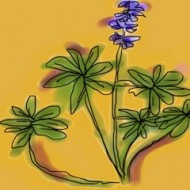The Dry Garden: Eco-snooping
The problem with selling native plants in garden centers is that the natives are reluctant seducers. For much of the autumn and winter — prime planting months in California — they’re discreet. Their foliage comes in the understated colors of a Craftsman paint palette. Give the plants too much water, and they rot in their pots. Flowers are few. Only in spring, usually far from town, safe distances from our hoses, do native lilacs lead the charge into blossom with a cobalt-blue eruption. After them come the pink and white spires of coral bells and clarkia, masses of orange poppies, along with every color of penstemon, irises and monkeyflowers. Only shoppers who know what a native looks like in spring can envision its potential in the fall, when it’s time to buy and plant.
By comparison, exotic plants are favored by retailers because their leaves often come in leprechaun greens. …
The Dry Garden: “Reimagining the California Lawn”
Maybe you want to remove your lawn. Maybe you want to reduce it to make way for flowers, food or a shade tree. Maybe you don’t know what you want. A new book, written by three of California’s most knowledgeable horticulturists, lays out options.
It would be disingenuous to treat Reimagining the California Lawn (Cachuma Press, 2011) like any other garden book. It’s not. The authors have close to rock star status in the Golden State, something they possessed even before the 2005 publication of their first book, California Native Plants for the Garden.
Carol Bornstein, now a Central California garden designer, was for many years director of horticulture of the Santa Barbara Botanic Garden. The heart-stoppingly beautiful meadow there is her work. In 1976, David Fross co-founded Native Sons Nursery in Arroyo Grande and has since been the Johnny Appleseed of dry gardening. For many years …
The Dry Garden: Don’t fence me in
The iconic images of Los Angeles sold to the world typically involve palm trees, beaches and freeways. Those of us who live here, however, know that the true symbol of Southern California is probably a fence. Fences are everywhere. Chain link fences, wrought iron fences, barbed wire fences. Brick, cinderblock, and river rock fences. There is so much redwood fencing that it’s a wonder there are any redwoods left.
Leaving aside how ironic it is that there should be outcry about a proposed fence for the home of the mayor of the city of fences, what is rarely considered in our highly framed world is what all this fencing does to plants. This is worth addressing because that impact is profound.
Click here to keep reading The Dry Garden in the Los Angeles Times.
Map of plume from Japan
UPDATED POST: A Comprehensive Test Ban Treaty Organization model of radioactive material from the disaster in Japan carried in the New York Times and Los Angeles Times has been removed from this post. Comments relating to the map have been removed. Anyone wishing to comment should go to those papers. This website, whose core mission is conservation, was being overwhelmed (see graphic above). For information about trace radiation in California from the Japan disaster, by all means check your air quality management district. Or check daily radiation levels from this RadNet Service from the US Environmental Protection Agency. No further comments to do with this remaining stub post will be published and earlier comments have been stricken.
March 25: National Public Radio has this excellent story about the Comprehensive Test Ban Treaty Organization monitoring, Built for bombs, Sensors now track Japan radiation.…
The Dry Garden: Boxy
Natalie Saavedra (3rd grader) at San Jose-Edison Academy School Garden in Covina, CA. Photo: Emily Green
Most people, save Atlantic magazine’s resident contrarian Caitlin Flanagan, agree that school gardens are a good thing. They encourage experimentation, critical thinking and healthful eating. Done right, they raise parental participation in schools. At their best, they’re as cute as a third-grader grubbing for worms.
Too often, however, teachers are defeated from the outset by the burden of installing and then maintaining a garden in addition to a classroom.
Click here to keep reading about a workable new model for schools in “The Dry Garden” in the Los Angeles Times.…
« go back — keep looking »

